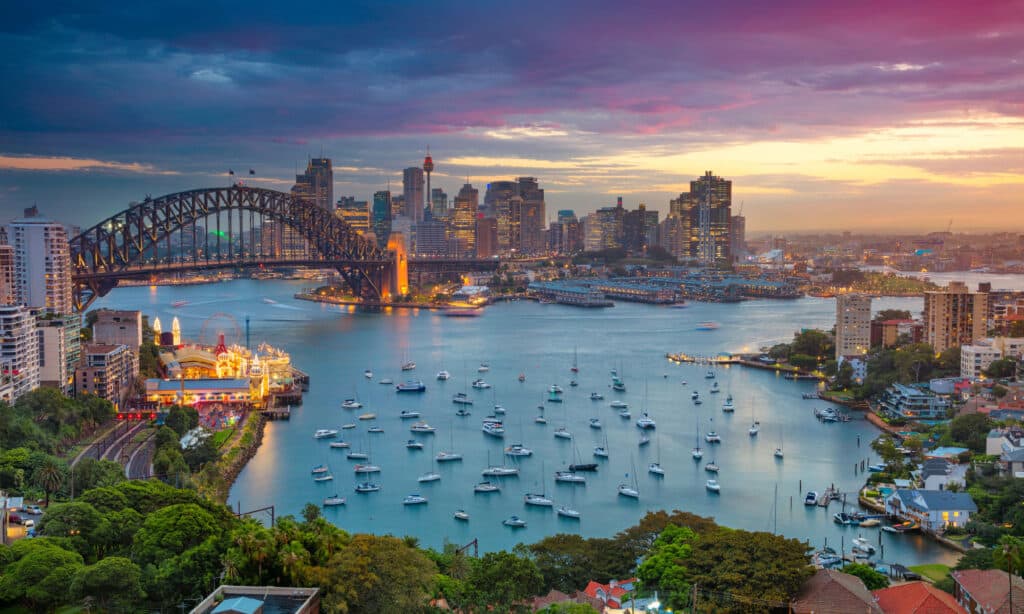The second largest city in Australia, Sydney is the most famous city in the country, often visited by tourists the world over. Folks come to see the wildlife such as kangaroos, catch a concert at the Sydney Opera House, or simply enjoy the vibrant culture of the beautiful island-continent nation. They might also be curious as to what animals in Sydney Harbour might be seen, caught, or eaten.
The coastal city rests along the Pacific Ocean, with several harbors butting her shores. The largest, and perhaps most famous by name, is Sydney Harbour. This unique harbor is actually thought to be the deepest and largest natural harbor on the planet, stretching 11 miles long and covering 21 square miles. More than 580 species of fish live here among the 13 islands throughout the harbor.

How Deep Is Sydney Harbour?

Some 1,200 large commercial vessels and thousands more recreational boats and ships come through Sydney Harbour.
©iStock.com/RudyBalasko
Sydney Harbour is one of the water bodies of Port Jackson. The harbor’s shallowest depth is 30 feet (9 meters) and the highest depth is 155 feet (47 meters) during low water times.
What Lives at the Bottom of Sydney Harbour?
The massive, natural harbor is home to a huge number of species both in the water and around the water, despite being in one of the largest cities in the country.
Fish, Crustaceans, and Other Marine Species

The blue tang, which is the only member of its genus, can be found in Sydney Harbour.
©Henner Damke/Shutterstock.com
596 species of fish, plus many shellfish, and other marine species have been recorded in Sydney Harbour. Just a few of them include:
- Convict surgeonfish
- Blue tang
- Eyestripe surgeonfish
- Spotted sawtail
- Australian sawtail
- Port Jackson glassfish
- Giant anglerfish
- Sargassum anglerfish
- Southern velvetfish
- Broadstripe cardinalfish
- Ruby cardinalfish
- Australian herring
- Giant sea catfish
- Eastern gobbleguts
- Bridled triggerfish
- Rotund blenny
- Piano fangblenny
- Pilotfish
- Silky shark
- Tiger shark
- Bull shark
- Dusky shark
- Klein’s butterflyfish
- Mahi mahi
- Smooth stingray
- Bluespotted maskray
- Giant squirrelfish
- Blue swimmer
- Mud crab
- Eastern rock lobster
- School prawn
- Sea urchins
- Sea-stars
- Sea cucumbers
- Seahorses.
Mammal, Amphibian, and Reptile Species

Americans might mistake dugongs for manatees. They’re similar and related to one another.
©Verde Massimo/Shutterstock.com
Many fascinating marsupials, amphibians, reptiles, and other mammals live in and around Sydney Harbour as well. These species include the:
- Koala
- Platypus
- Kangaroo
- Wombat
- Bat
- Short-beaked echidna
- Common ringtail possum
- Swamp wallaby
- Brushtail possum
- Brush-tailed rock-wallaby
- Echidna
- Eastern pygmy possum
- Possum
- Fur seal
- Bottlenose dolphin
- Whale
- Dugong
- Green turtle.
Bird Species

The little blue penguin, or fairy penguin, can sometimes be spotted in Sydney Harbour.
©Khoroshunova Olga/Shutterstock.com
Australia is a birdwatcher’s paradise as it has about 850 species of birds, with around 45% of these only found in the country. The waters and surrounding areas of Sydney Harbour provide a home to some of these bird species, including:
- Fairy penguins
- Superb fairywrens
- Galahs
- Kookaburras
- Eurasian coots
- Pied currawongs
- Australian magpies
- Sulfur-crested cockatoos
- Australian pelicans
- Rainbow lorikeets
- Spotted doves
- Red-whiskered bulbuls
- Common minas
- Common starlings
- Black swans
- Chestnut teals
- White-faced herons
- Purple swamphens
- Fan-tailed cuckoos.
Rare and Endangered Animals Near Sydney Harbour
Sydney Harbour contains many species of seahorses, but the Sydney Seahorse is the only threatened species living in the harbour. Only two species of seahorses are currently deemed endangered, with the Sydney seahorse being the second to go on the list. Populations of this beautiful marine animal have declined largely due to the degradation of their habitat in the harbor.
Interesting Facts About Sydney Harbour

The Sydney Opera House is an iconic landmark of Sydney Harbour.
©wasiolka/Shutterstock.com
- Sydney Harbour is home to the Sydney Opera House, which is located in the area of Circular Quay.
- The Sydney Harbour Bridge crosses over the harbor, overlooks the Opera House and connects Sydney’s central business district to the north shore of the city.
- 100 people and two robots spend their lives repainting the Sydney Harbour Bridge nearly constantly to keep it protected from the elements. It takes so long that as soon as it’s finished, they start over again.
- Paul Hogan (star of the “Crocodile Dundee” movies) once worked as a rigger on the Harbour Bridge.
- Sydney Harbour has its own measuring unit: the Sydharb. One Sydharb is the official Australian unit of volume which is equivalent to 500 gigaliters, the volume of water in the harbor.
- Fish caught in Sydney Harbour aren’t the healthiest choice for dining. Anything caught west of the Harbour Bridge should not be eaten, and anything caught east of the bridge should be limited to 5.29 ounces weekly. High levels of dioxins have been recorded in the flesh of the fish, creating this health hazard.
- Craved out of sandstone, Sydney Harbour is actually a drowned estuary. It’s believed this occurred about 29 million years ago, followed by the rising sea level drowning it about 17,000 years ago, and mostly creating the harbor we know today.
The photo featured at the top of this post is © iStock.com/RudyBalasko
Thank you for reading! Have some feedback for us? Contact the AZ Animals editorial team.






